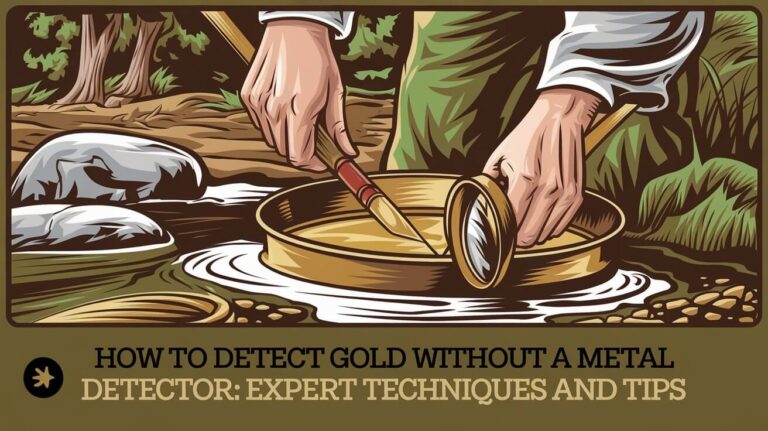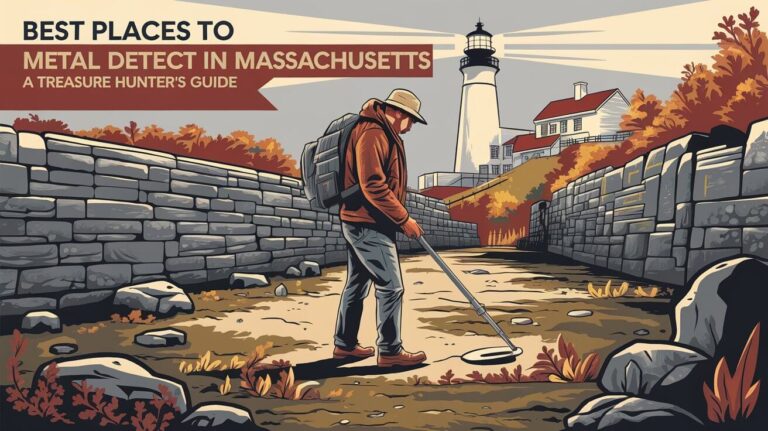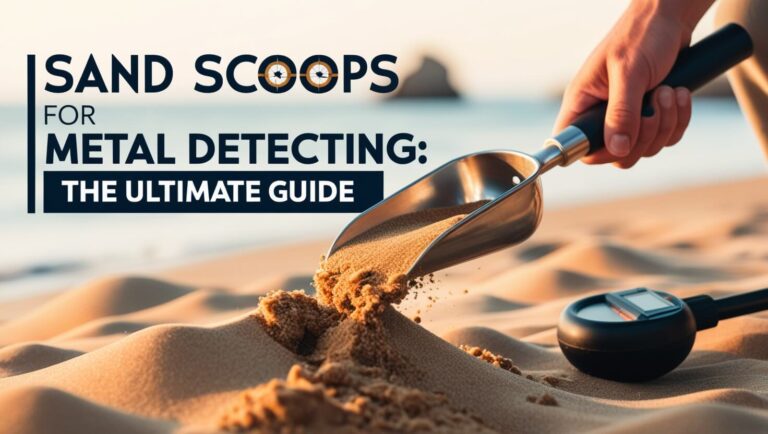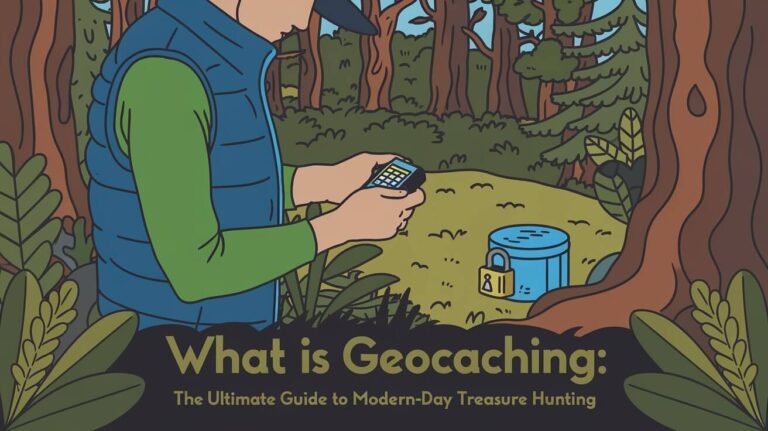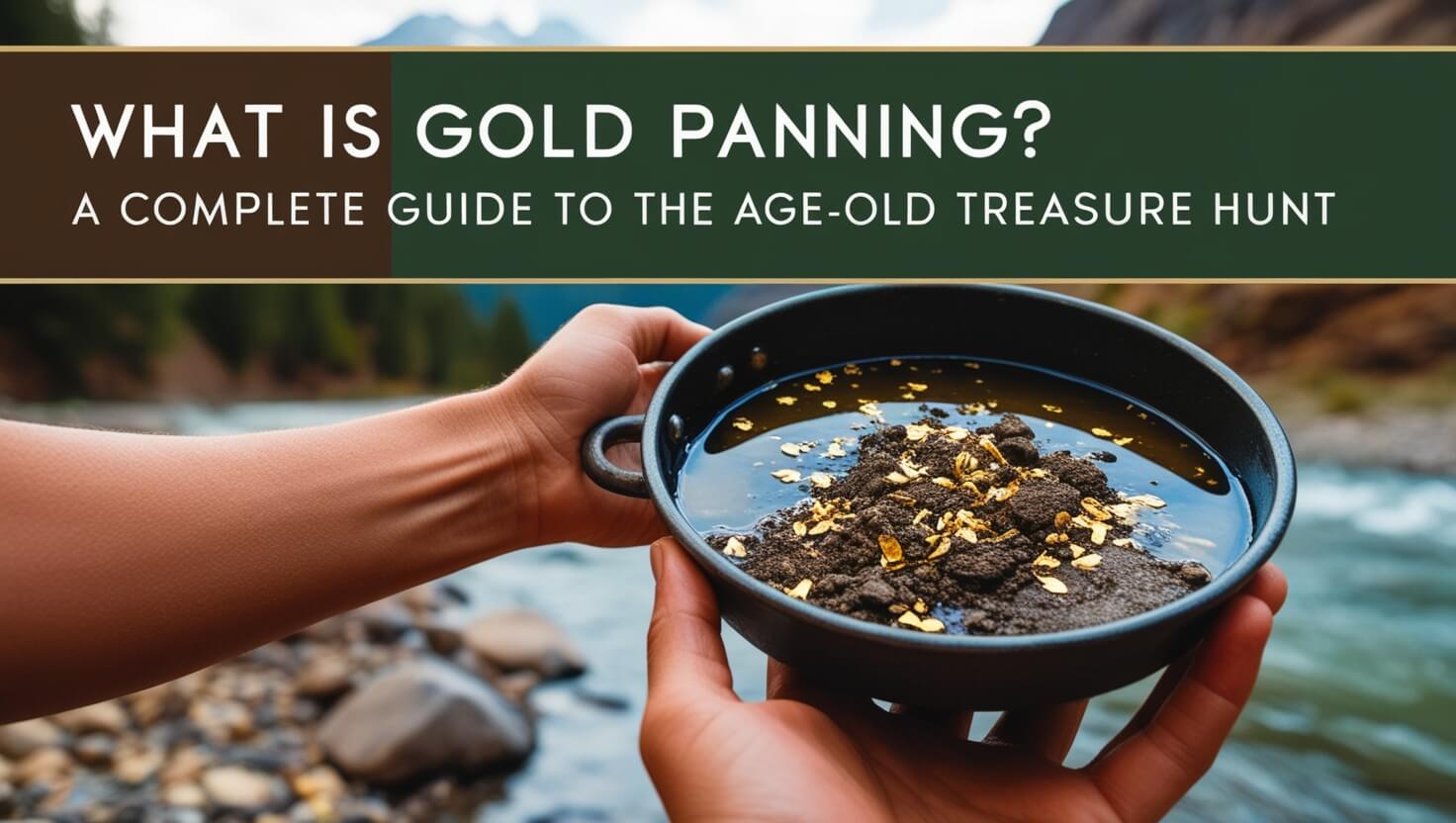
Gold panning is a simple yet exciting method of searching for gold in rivers and streams. It involves using a shallow pan to separate gold particles from sediment through a washing technique. This ancient practice has captivated treasure hunters for centuries and continues to be popular today.
In this guide, we’ll explore every aspect of gold panning. From its rich history to modern techniques, we’ll cover all you need to know to start your own gold panning adventure.
Introduction to Gold Panning
Definition and Basic Concept
Gold panning is a form of placer mining. It uses water to separate heavy gold particles from lighter sediments in a pan. The process relies on gold’s high density, which causes it to sink faster than other materials.
Panners scoop sediment from riverbeds or streams into their pans. They then shake and swirl the pan in water. This motion washes away lighter materials, leaving behind heavier gold particles.
Historical Significance of Gold Panning
Gold panning has shaped human history. It played a crucial role in many gold rushes around the world. The California Gold Rush of 1849 is perhaps the most famous example.
These gold rushes led to rapid population growth and economic booms in many regions. They also spurred technological advancements in mining techniques.
Today, gold panning remains popular. It’s both a hobby and, in some cases, a way to supplement income.
The Fundamentals of Gold Panning
How Gold Panning Works
Gold panning works on a simple principle: gold is heavy. Much heavier than most other materials found in rivers and streams.
Here’s a basic breakdown of the process:
- Fill the pan with sediment from a promising location.
- Submerge the pan in water.
- Shake the pan to settle the heavier materials at the bottom.
- Tilt the pan and wash away the top layer of lighter sediments.
- Repeat until only the heaviest materials remain.
With practice, you’ll be able to spot the tell-tale glimmer of gold among the remaining sediments.
Where to Find Gold
Gold can be found in many places, but some locations are more promising than others. Look for:
- Areas downstream from known gold deposits
- Bends in rivers where water slows down
- Crevices in bedrock
- The inside curve of rivers
- Behind large boulders in streams
Remember, gold is often found where it has been before. Research local geology and mining history to find promising spots.
Best Conditions for Gold Panning
Timing can greatly affect your gold panning success. Consider these factors:
- Season: Spring is often best, after winter floods have moved gold-bearing sediments.
- Water level: Lower water levels make panning easier and safer.
- Recent weather: Heavy rains can expose new gold deposits.
Always prioritize safety. Never pan in dangerous water conditions or unstable areas.
Essential Equipment for Gold Panning
Gold Pans: Types and Selection
Your gold pan is your most important tool. Two main types exist:
- Metal pans: Traditional and durable. They’re heavier but can last a lifetime.
- Plastic pans: Lighter and often have built-in riffles to catch gold. They come in bright colors to help spot gold.
Choose a pan that feels comfortable in your hands. Most panners prefer 12-14 inch diameter pans.
Additional Tools and Gear
While a pan is all you need to start, these tools can improve your panning:
- Classifier sieve: Helps remove larger rocks before panning.
- Snuffer bottle: For collecting small gold flakes.
- Tweezers: To pick up larger gold pieces.
- Magnifying glass: For examining your finds.
- Vials: To store your gold safely.
Safety Equipment
Safety should always come first. Don’t forget:
- Waterproof boots or waders
- Sun protection (hat, sunscreen, sunglasses)
- First aid kit
- Drinking water
- Cell phone in a waterproof case
Gold Panning Techniques
Step-by-Step Guide to Panning for Gold
- Fill your pan about 3/4 full with sediment.
- Submerge the pan in water, just below the surface.
- Shake the pan side to side to settle heavier materials.
- Tilt the pan away from you at a slight angle.
- Use circular motions to wash lighter materials over the edge.
- Repeat steps 4 and 5 until only a small amount of material remains.
- Look for gold among the remaining sediments.
Advanced Techniques for Experienced Panners
As you gain experience, try these advanced techniques:
- The “corkscrew” method: A twisting motion that can separate gold more efficiently.
- Dry panning: Useful in areas with limited water.
- Using a metal detector alongside panning to locate larger nuggets.
Common Mistakes to Avoid
Even experienced panners make mistakes. Watch out for these:
- Overloading your pan
- Panning too quickly
- Failing to classify material before panning
- Ignoring safety precautions
- Not researching locations thoroughly
Understanding Gold Deposits
Types of Placer Deposits
Placer deposits are where loose gold accumulates in sand and gravel. Common types include:
- Alluvial: Found in current or ancient riverbeds.
- Eluvial: Formed by weathering of gold-bearing rocks.
- Beach placers: Gold deposits on beaches.
Understanding these can help you choose the best panning locations.
Identifying Gold-Bearing Areas
Look for these signs of potential gold:
- Black sand (magnetite)
- Garnets or other heavy minerals
- Quartz veins in surrounding rocks
- Old mine tailings
Reading the Landscape for Potential Gold Spots
Natural features can indicate good panning spots:
- Inside bends of rivers
- Areas where water flow slows
- Behind large obstacles in streams
- Bedrock crevices
- Dry river banks (for ancient placer deposits)
Legal Aspects of Gold Panning
Regulations and Permits
Gold panning rules vary widely. Always check local regulations. You may need:
- Prospecting permits
- Permission from landowners
- Special equipment licenses
Some areas prohibit gold panning entirely. Always pan legally to avoid fines or legal trouble.
Public Lands vs. Private Property
On public lands, panning rules differ between agencies:
- Bureau of Land Management (BLM) lands often allow recreational panning.
- National Parks usually prohibit gold panning.
- National Forests may allow panning with restrictions.
For private property, always get the owner’s permission first.
Responsible Gold Panning Practices
Practice ethical panning:
- Fill in any holes you dig
- Pack out all trash
- Avoid disturbing wildlife habitats
- Respect other panners’ claims
- Don’t use mercury or other harmful substances
Gold Panning Locations Around the World
Famous Gold Panning Sites
Some renowned gold panning locations include:
- Sierra Nevada, California
- Yukon River, Alaska
- Pilgrim’s Rest, South Africa
- Victorian Goldfields, Australia
- River Tay, Scotland
These sites often have rich histories and established panning communities.
Lesser-Known Gold Panning Destinations
Don’t overlook these often-overlooked spots:
- Atlin, British Columbia
- Typhoon Lagoon, Florida (yes, at Disney World!)
- Jamestown, California
- Cripple Creek, Colorado
- Gold Prospecting Adventures, Jamestown
Organized Gold Panning Tours and Experiences
For beginners, guided experiences can be great:
- Bering Sea Gold Tours, Nome, Alaska
- Gold Prospecting Adventures, California
- Gold Panning at Sovereign Hill, Australia
These tours often provide equipment and expert guidance.
The Science Behind Gold Formation
Geological Processes That Create Gold Deposits
Gold forms deep within the Earth under extreme conditions:
- High pressure and temperature
- Hydrothermal activity
- Plate tectonics
Over millions of years, these processes concentrate gold into economically viable deposits.
Mineral Associations with Gold
Gold often occurs with other minerals:
- Quartz
- Pyrite (fool’s gold)
- Silver
- Copper
Learning to identify these can help you locate gold.
Gold Panning as a Hobby
Getting Started with Recreational Gold Panning
To start gold panning:
- Research local panning areas
- Invest in basic equipment
- Learn proper techniques
- Join a local club or take a class
- Practice, practice, practice!
Remember, patience is key. Don’t expect to strike it rich overnight.
Joining Gold Panning Clubs and Communities
Gold panning clubs offer many benefits:
- Shared knowledge and experience
- Group outings
- Equipment sharing
- Friendship with like-minded individuals
Look for local clubs or join online communities to connect with other panners.
Family-Friendly Gold Panning Activities
Gold panning can be a great family activity:
- Teaches patience and persistence
- Provides outdoor exercise
- Offers a chance to learn about geology and history
- Creates lasting memories
Many tourist areas offer safe, family-friendly panning experiences.
From Panning to Mining: Scaling Up
When to Consider More Advanced Mining Methods
Signs you might be ready to scale up:
- Consistently finding significant amounts of gold
- Desire to explore deeper deposits
- Interest in more efficient extraction methods
Always consider the increased costs and regulations of larger-scale operations.
Small-Scale Mining Equipment
Beyond panning, you might explore:
- Sluice boxes
- Rocker boxes
- Suction dredges (where legal)
- Metal detectors
Each method has pros and cons. Research thoroughly before investing.
Environmental Considerations
Larger operations have bigger environmental impacts:
- Soil erosion
- Water pollution
- Habitat disruption
Always follow best practices to minimize your environmental footprint.
The Economics of Gold Panning
Can You Make Money Gold Panning?
While possible, it’s rare to make a living solely from recreational gold panning. Factors to consider:
- Gold prices
- Amount of gold found
- Time invested
- Equipment costs
- Travel expenses
For most, gold panning remains a hobby rather than a primary income source.
Valuing Your Gold Finds
To value your gold:
- Separate gold from other materials
- Weigh your gold (usually in grams or troy ounces)
- Check current gold prices
- Consider purity (placer gold is rarely 100% pure)
Remember, some gold specimens may be worth more to collectors than their melt value.
Selling Gold: Options and Considerations
Options for selling gold include:
- Local gold buyers
- Online buyers
- Pawn shops
- Jewelers
- eBay or similar platforms
Always get multiple offers and understand the terms before selling.
Gold Panning in Popular Culture
Gold Panning in Literature and Film
Gold panning has inspired countless stories:
- “The Gold-Bug” by Edgar Allan Poe
- “The Call of the Wild” by Jack London
- Films like “The Treasure of the Sierra Madre”
These works often romanticize gold panning, focusing on the thrill of discovery.
Modern Gold Rushes and Media Coverage
Recent gold rushes have captured media attention:
- 2010-2011 Yukon Gold Rush
- 2013 Gold Rush in Galice, Oregon
Reality TV shows like “Gold Rush” have also popularized modern gold prospecting.
Preserving the Art of Gold Panning
Educational Programs and Workshops
Many organizations offer gold panning education:
- State and national parks
- Mining museums
- Prospecting clubs
- Community colleges
These programs help preserve traditional panning techniques.
Museums and Historical Sites Dedicated to Gold Panning
Visit these sites to learn about gold panning history:
- Marshall Gold Discovery State Historic Park, California
- Dahlonega Gold Museum, Georgia
- Gold Museum, Ballarat, Australia
These places often offer hands-on panning experiences.
The Future of Gold Panning
Technological Advancements in Gold Detection
New technologies are changing gold prospecting:
- Improved metal detectors
- Drone surveying
- GPS mapping
- Portable X-ray fluorescence (XRF) analyzers
These tools can make prospecting more efficient, but traditional panning skills remain valuable.
Sustainability and Environmental Concerns
The future of gold panning must address:
- Habitat preservation
- Water quality protection
- Responsible land use
Many areas now require environmentally friendly panning practices.
Gold Panning in the Digital Age
Digital resources for gold panners are growing:
- Online claim maps
- Mobile apps for identifying minerals
- Virtual reality panning simulations
- Online communities for sharing tips and locations
These tools complement, rather than replace, hands-on experience.
Conclusion: The Enduring Allure of Gold Panning
Gold panning has come a long way since its ancient origins. Today, it blends traditional techniques with modern technology. Whether you’re seeking fortune, adventure, or simply a connection with nature and history, gold panning offers something for everyone.
Remember, the true value of gold panning often lies not in the gold itself, but in the experience. The fresh air, the rush of the stream, the thrill of discovery – these are the real treasures that keep people coming back to gold panning year after year.
So grab a pan, head to a stream, and who knows? You might just strike gold. Happy panning!


